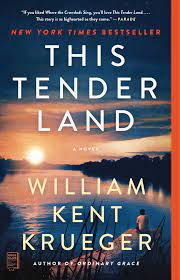Inspired by our recent visit to the "Away From Home Exhibit" ( https://ontheroadwiththehistocrats.blogspot.com/2022/02/away-from-home-far-far-away.html ), I read three books that present three different takes on the Indian Boarding School movement of the 20th century, one memoir and two novels.
The memoir is Pipestone: My Life in an Indian Boarding School is written by Adam Fortunate Eagle,
a leader of the Indian takeover of Alcatraz Island in 1969. From 1935 to 1945, he and his siblings were students at Pipestone Indian Boarding School in Minnesota. It is not what I expected at all from a "radical" indigenous rights leader, considering my knowledge of boarding schools and reading and hearing stories of abuse and cruelty. In this memoir, Fortunate Eagle almost looks back on these years wistfully, writing about dormitory pranks and memories of fun. There are a few poignant moments here and there, but he recalls his time at Pipestone as nothing less than "a little bit of heaven." It's a vivid example of the fact that history has a multitude of perspectives, and one shouldn't really on just one point of view or source, but including Pipestone on a reading list about Indian boarding schools paints a more complete, and accurate, picture.
This Tender Land is a novel set in 1932 at the Lincoln School for Indian boys and girls. It's an adventure novel focusing on the four children, Albert, Odie, Emmy, and Mose. Mose is the only Native American of the four. Albert and Odie are white orphans who find themselves the only white children enrolled at Lincoln. Emmy is the young daughter of one of the school's staff members. While at Lincoln, Odie, Albert and other Indian children suffer the cruelty and abuse dished out by the Superintendents of the the school, the Brickmans, and other staff members. When a tornado kills Emmy's mother, one of the few good staff members, Emmy is placed in the Brickman's foster care. The four children decide to escape by taking a canoe down the Mississippi River to Odie and Albert's aunt in St. Louis. Pursued by the law and the Brickmans as kidnappers of Emmy, the children have encounters various interesting characters including a Lakota man who helps Mose get in touch with his Lakota culture, the residents of a Hooverville, Bonus Army agitators headed to Washington, and a faith-healing evangelist named Sister Eve. It's a one of those great American journey books, reminiscent of Huckleberry Finn, Tom Sawyer, O Brother Where Art Thou, and Big Fish. So, in other words, it's a variation of Homer's Odyssey. It's also a tale of the Great Depression that will appeal to fans of The Grapes of Wrath and Kristin Hannah's The Four Winds. It's an entertaining journey.
Murder on the Red River, at first glance, is not an Indian boarding school book, but it does fit, trust me. It is the first of a series of mysteries starring Cash Blackbear. Cash is a 19 year old Native American girl who was taken from her mother at age two and shuffled from one abusive white foster home to another in rural Minnesota in the 1950s and 1960s. She faces racism every day at school and from her foster families, who basically take in Indian foster kids for the sole purpose of adding farm labor, and the children are treated as labor, or worse. By age 13, she is an expert driver of farm trucks and tractors and works day and night on farms, and hustles pool in her free time. She has one benefactor/supporter in her life, the local sheriff, who has been the only person she can count on. The story of the book takes place about 1970, when two murders of migrant farm workers, one Indian and one white, take place. The sheriff calls Cash in to help investigate because she has a special sense, that allows her to see things others can't. So how does this relate? Well, the boarding school movement was not the only thing affecting Native American families. It seems that in Minnesota, and probably other states with large indigenous populations, the state's first reaction to family stress within indigenous families was to take the children away and put them in the inadequate and possibly dangerous foster care system, where abuse and isolation from family and culture had a huge detrimental effect on generations of indigenous children.




No comments:
Post a Comment